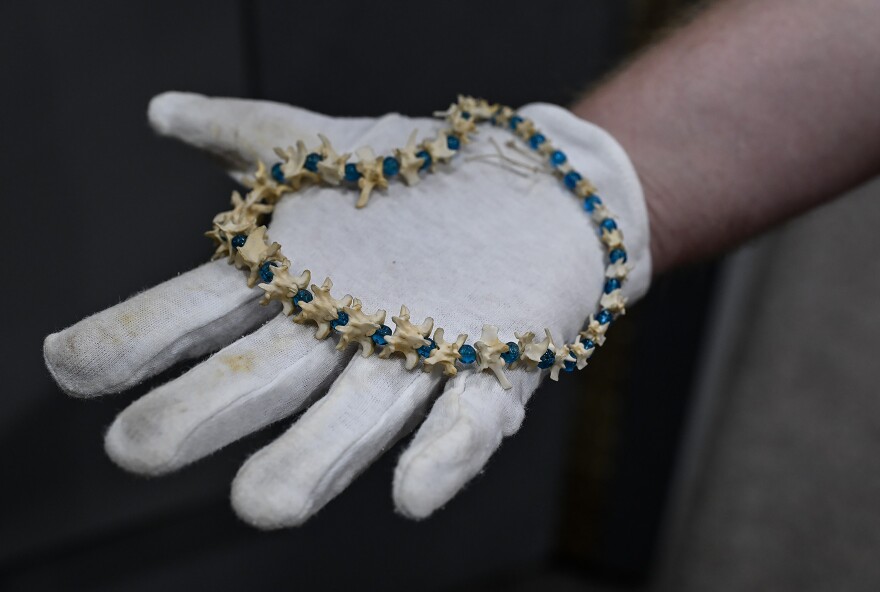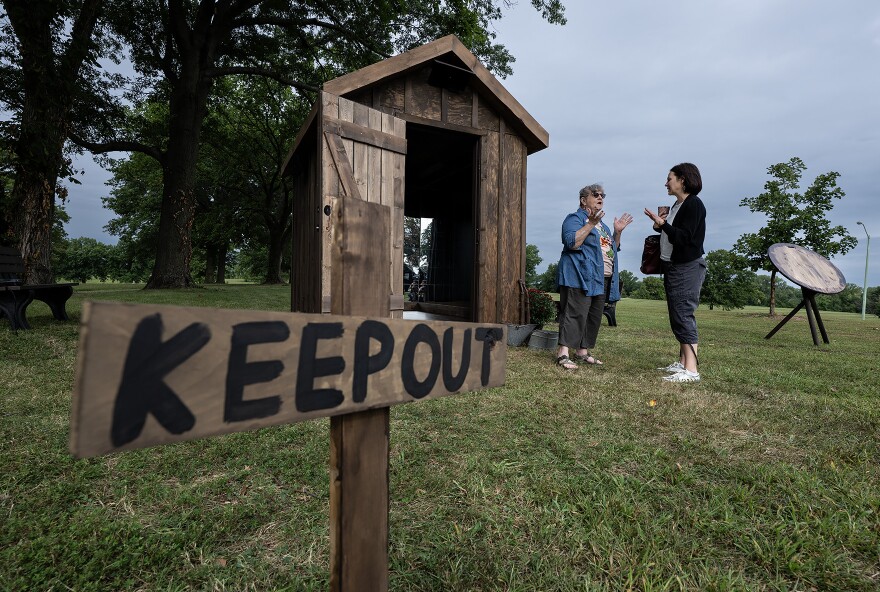Chief Judith Manthe, of the Wyandot Nation of Kansas, has spent a lifetime collecting family stories, books, and newspaper articles about Lyda, Helena, and Ida Conley, and their battle to protect a tribal burial ground threatened by development in the early 1900s.
“The Conley sisters were amazing,” Manthe said. “They didn't put up with anything — and my husband says I'm a strong Wyandot woman, just like them.”
Manthe is co-director of “Trespassers Beware: Fort Conley and Wyandot Women Warriors,” a new art installation that opens Aug. 30 at Wyandotte County Historical Museum. It’s a collaboration between the Wyandot Nation of Kansas and Monumenta, an initiative that commemorates unsung stories in public art.
Manthe is also a cousin of Lyda Conley, and her research into the family history will help tell the story of the sisters who occupied Huron Indian Cemetery, now known as the Wyandot National Burying Ground, in 1906 to save it from development.
“If this council attempts to desecrate my mother’s grave, they will have something on their hands that they had not bargained for,” Lyda Conley told The Weekly Gazette Globe in 1907. “I will protect my mother’s grave every night, and I want to warn everyone to keep away from the Huron Cemetery,”
To defend the cemetery, the sisters built a tiny fort made out of wood. Armed with their father’s shotgun, they locked the gate and hung a sign to warn trespassers.
“For two solid years they stayed in that shack," Manthe said. “People don't realize a 6-by-8 shack is very, very small."

The Conleys wanted to stop plans by William E. Connelley, a historian and land surveyor with power of attorney for the Wyandotte Tribe of Oklahoma, who had successfully passed a clause into federal law that stripped the cemetery of its protected status and ordered the bodies buried there to be excavated.
“No matter how hot in the summer or how cold in the winter it got,” Manthe said. “And they kept everybody off that ground.”
Thanks to the Conley sisters and their vigilance, the cemetery still stands today.
The KCUR podcast A People’s History of Kansas City told the story of the Conley sisters’ fight in 2020.
Neysa Page-Lieberman, founder and artistic director of Monumenta, co-directs the project with Manthe. She said great care was taken to create an authentic experience for exhibit visitors who may be unfamiliar with the history.
“When visitors experience the actual fort, they should know that the dimensions are the actual dimensions that the Conley sisters had to live within,” Page-Lieberman said.
Fort Conley’s reimagination as a multimedia installation started in October 2024, when Monumenta commissioned the Omakyehstih Collective, a group of artists from the Wyandotte Nation of Oklahoma. The artists built a replica of the fort, then filmed actors recreating scenes from the Conley sisters’ stand.
Those scenes play out for visitors inside the new exhibit.
“When you first see the fort, you might say, ‘Wow, that is really small,’” Page-Lieberman said. “Then, when you enter that space, you're going to see this expansive world that reflects both Wyandot history and culture, and the experiences of these three heroic — and that is not an understatement to say they were heroic people — who succeeded in protecting this space.”

Wyandotte County Museum allowed the film production to borrow historical artifacts that once belonged to the Conley sisters, including the shotgun they brandished but never fired.
“We were able to borrow Helena's rattlesnake necklace that she wore as an amulet,” Page-Lieberman said. “She would threaten curses on anybody that disturbed the graves, and wore that necklace all the time.”
As Page-Lieberman researched the project, many people she spoke with about it were unaware of the crusade to protect the cemetery.
“The person who has really been keeping this alive is Chief Judith Manthe,” Page-Lieberman. “She has been a walking, talking monument to this project for a long time, and she has made it her life's mission to make sure that the truth is told, and that this is carried on to younger generations. Because if it's not, it will be lost.”

Manthe said each Conley sister played a role in the story.
“Ida was the oldest and she was pretty much the caretaker” Manthe said. “Helena was a force to be reckoned with and, of course, Lyda was the scholar.”
Lyda Conley eventually earned a law degree and led the Wyandot tribe’s case in court. She argued selling the cemetery would violate prior treaties.
When the case was advanced in 1910, Lyda Conley became the first Native American woman to argue a case before the U.S. Supreme Court.
“This is sacred ground and we need to protect it, and I think the more people that understand that, the better,” said Manthe, who has generations of family buried at the Wyandot National Burying Ground. “These are my family members. I do not want them moved.”
“Trespassers Beware: Fort Conley and Wyandot Women Warriors” unveiling, 1 p.m. on Saturday, Aug. 30 at the Wyandotte County Historical Society and Museum, 631 N. 126th St., Bonner Springs, Kansas 66012. For more information, go to MonumentaArt.org.


